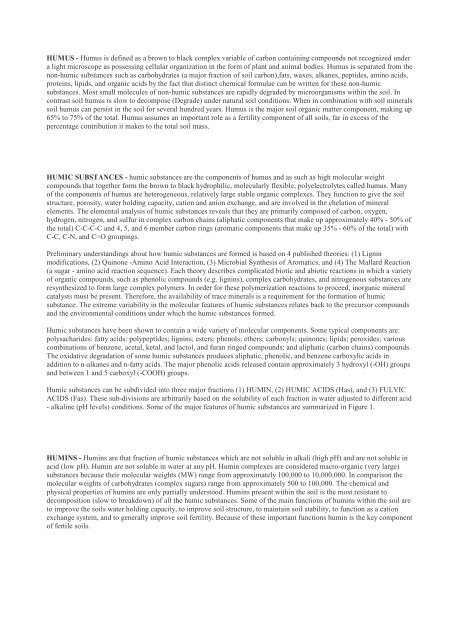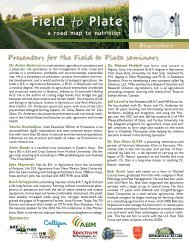organic matter, humus, humate, humic acid, fulvic acid, and humin
organic matter, humus, humate, humic acid, fulvic acid, and humin
organic matter, humus, humate, humic acid, fulvic acid, and humin
Create successful ePaper yourself
Turn your PDF publications into a flip-book with our unique Google optimized e-Paper software.
HUMUS - Humus is defined as a brown to black complex variable of carbon containing compounds not recognized under<br />
a light microscope as possessing cellular organization in the form of plant <strong>and</strong> animal bodies. Humus is separated from the<br />
non-<strong>humic</strong> substances such as carbohydrates (a major fraction of soil carbon),fats, waxes, alkanes, peptides, amino <strong>acid</strong>s,<br />
proteins, lipids, <strong>and</strong> <strong>organic</strong> <strong>acid</strong>s by the fact that distinct chemical formulae can be written for these non-<strong>humic</strong><br />
substances. Most small molecules of non-<strong>humic</strong> substances are rapidly degraded by microorganisms within the soil. In<br />
contrast soil <strong>humus</strong> is slow to decompose (Degrade) under natural soil conditions. When in combination with soil minerals<br />
soil <strong>humus</strong> can persist in the soil for several hundred years. Humus is the major soil <strong>organic</strong> <strong>matter</strong> component, making up<br />
65% to 75% of the total. Humus assumes an important role as a fertility component of all soils, far in excess of the<br />
percentage contribution it makes to the total soil mass.<br />
HUMIC SUBSTANCES - <strong>humic</strong> substances are the components of <strong>humus</strong> <strong>and</strong> as such as high molecular weight<br />
compounds that together form the brown to black hydrophilic, molecularly flexible, polyelectrolytes called <strong>humus</strong>. Many<br />
of the components of <strong>humus</strong> are heterogeneous, relatively large stable <strong>organic</strong> complexes. They function to give the soil<br />
structure, porosity, water holding capacity, cation <strong>and</strong> anion exchange, <strong>and</strong> are involved in the chelation of mineral<br />
elements. The elemental analysis of <strong>humic</strong> substances reveals that they are primarily composed of carbon, oxygen,<br />
hydrogen, nitrogen, <strong>and</strong> sulfur in complex carbon chains (aliphatic components that make up approximately 40% - 50% of<br />
the total) C-C-C-C <strong>and</strong> 4, 5, <strong>and</strong> 6 member carbon rings (aromatic components that make up 35% - 60% of the total) with<br />
C-C, C-N, <strong>and</strong> C=O groupings.<br />
Preliminary underst<strong>and</strong>ings about how <strong>humic</strong> substances are formed is based on 4 published theories: (1) Lignin<br />
modifications, (2) Quinone -Amino Acid Interaction, (3) Microbial Synthesis of Aromatics, <strong>and</strong> (4) The Mallard Reaction<br />
(a sugar - amino <strong>acid</strong> reaction sequence). Each theory describes complicated biotic <strong>and</strong> abiotic reactions in which a variety<br />
of <strong>organic</strong> compounds, such as phenolic compounds (e.g. lignins), complex carbohydrates, <strong>and</strong> nitrogenous substances are<br />
resynthesized to form large complex polymers. In order for these polymerization reactions to proceed, in<strong>organic</strong> mineral<br />
catalysts must be present. Therefore, the availability of trace minerals is a requirement for the formation of <strong>humic</strong><br />
substance. The extreme variability in the molecular features of <strong>humic</strong> substances relates back to the precursor compounds<br />
<strong>and</strong> the environmental conditions under which the <strong>humic</strong> substances formed.<br />
Humic substances have been shown to contain a wide variety of molecular components. Some typical components are:<br />
polysacharides: fatty <strong>acid</strong>s: polypeptides; lignins; esters: phenols; ethers; carbonyls; quinones; lipids; peroxides; various<br />
combinations of benzene, acetal, ketal, <strong>and</strong> lactol, <strong>and</strong> furan ringed compounds; <strong>and</strong> aliphatic (carbon chains) compounds.<br />
The oxidative degradation of some <strong>humic</strong> substances produces aliphatic, phenolic, <strong>and</strong> benzene carboxylic <strong>acid</strong>s in<br />
addition to n-alkanes <strong>and</strong> n-fatty <strong>acid</strong>s. The major phenolic <strong>acid</strong>s released contain approximately 3 hydroxyl (-OH) groups<br />
<strong>and</strong> between 1 <strong>and</strong> 5 carboxyl (-COOH) groups.<br />
Humic substances can be subdivided into three major fractions (1) HUMIN, (2) HUMIC ACIDS (Has), <strong>and</strong> (3) FULVIC<br />
ACIDS (Fas). These sub-divisions are arbitrarily based on the solubility of each fraction in water adjusted to different <strong>acid</strong><br />
- alkaline (pH levels) conditions. Some of the major features of <strong>humic</strong> substances are summarized in Figure 1.<br />
HUMINS - Humins are that fraction of <strong>humic</strong> substances which are not soluble in alkali (high pH) <strong>and</strong> are not soluble in<br />
<strong>acid</strong> (low pH). Humin are not soluble in water at any pH. Humin complexes are considered macro-<strong>organic</strong> (very large)<br />
substances because their molecular weights (MW) range from approximately 100,000 to 10,000,000. In comparison the<br />
molecular weights of carbohydrates (complex sugars) range from approximately 500 to 100,000. The chemical <strong>and</strong><br />
physical properties of <strong>humin</strong>s are only partially understood. Humins present within the soil is the most resistant to<br />
decomposition (slow to breakdown) of all the <strong>humic</strong> substances. Some of the main functions of <strong>humin</strong>s within the soil are<br />
to improve the soils water holding capacity, to improve soil structure, to maintain soil stability, to function as a cation<br />
exchange system, <strong>and</strong> to generally improve soil fertility. Because of these important functions <strong>humin</strong> is the key component<br />
of fertile soils.



